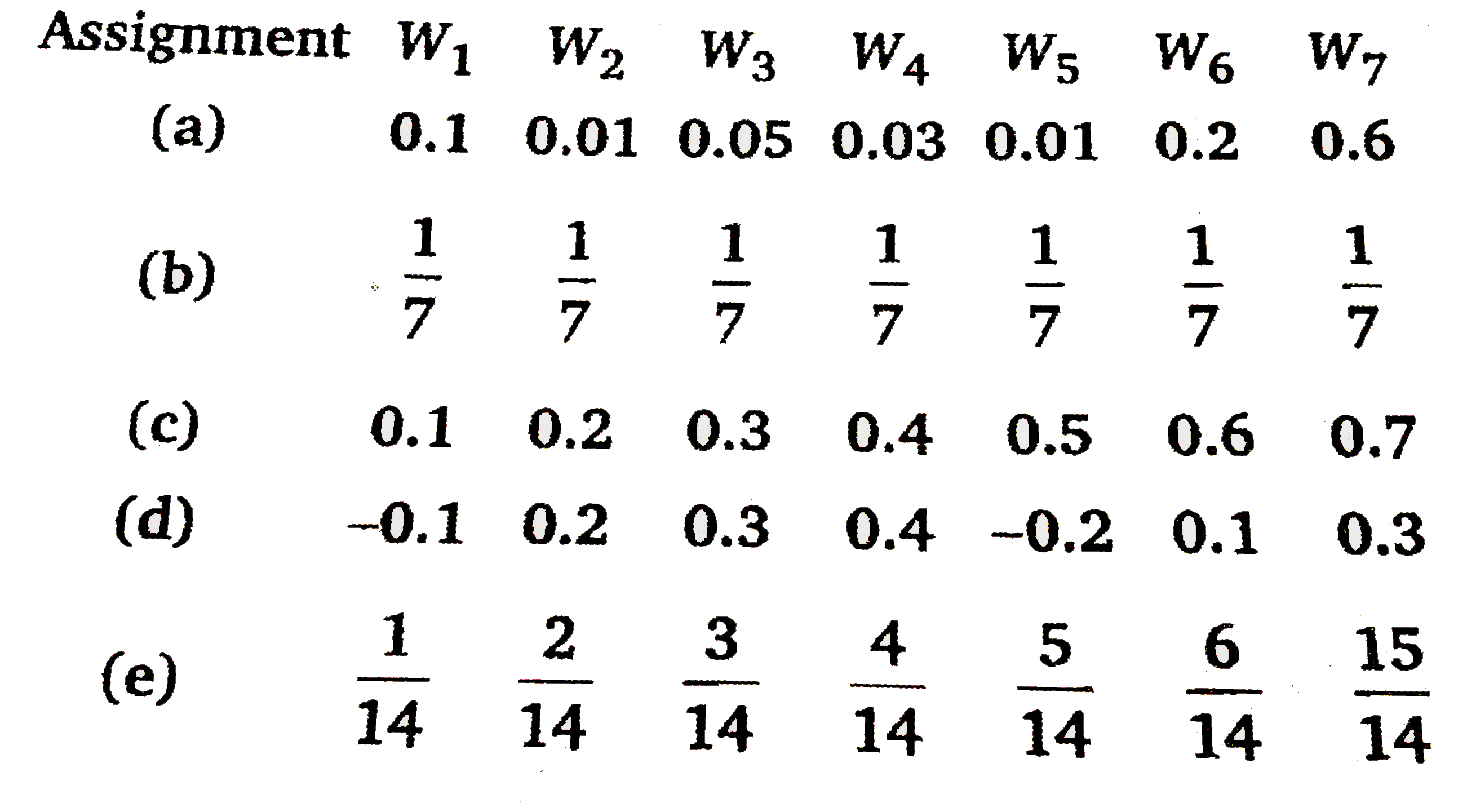An unbiased dice, with faces numbered 1,2,3,4,5,6, is thrown n times and the list of n numbers shown up is noted. Then find the probability that among the numbers 1,2,3,4,5,6 only three numbers appear in this list.Solution in Bengali
When a dice is rolled n times, total number of cases is 6n Let us first select three numbers which appear.
Three numbers can be selected from six .6C3 ways. Now each of these three numbers appear at least once. This is same as filling three different boxes with n different objects such that no box remains empty.
Number of ways of such distribution using the principle of inclusion-exclusion = 3n−.3C1(3−1)n+.3C2(3−2)n
=3n−3×2n+3
∴ Required probability = (3n−3×2n+3)×.6C36n
Topper's Solved these Questions
- PROBABILITY I BOOK - CENGAGE PUBLICATIONCHAPTER - PROBABILITY I EXERCISE - Solved Example
9 Videos
- PROBABILITY I BOOK - CENGAGE PUBLICATIONCHAPTER - PROBABILITY I EXERCISE - Exercise 9.1
6 Videos
- PROBABILITYBOOK - CENGAGE PUBLICATIONCHAPTER - PROBABILITYEXERCISE - All Questions
470 Videos
- PROBABILITY IIBOOK - CENGAGE PUBLICATIONCHAPTER - PROBABILITY IIEXERCISE - MULTIPLE CORRECT ANSWER TYPE
6 Videos
Similar Questions
When a fair dice is rolled, the number that comes up top is a number between one to six. Assuming we roll the dice once, to check the possibility of three coming up.
View SolutionWhich of the following cannot be valid assignment of probabilities for outcomes of sample space S={W1,W2,W3,W4,W5,W6,W7}

View SolutionA coin is tossed three times, consider the following events. A : ‘No head appears’, B: ‘Exactly one head appears’ and C: ‘Atleast two appear’. Do they form a set of mutually exclusive and exhaustive events?
View SolutionLet EandF be two independent events. The probability that exactly one of them occurs is 1125 and the probability if none of them occurring is 225. If P(T) denotes the probability of occurrence of the event T, then (a) P(E)=45,P(F)=35 (b) P(E)=15,P(F)=25 (c) P(E)=25,P(F)=15 (d) P(E)=35,P(F)=45
View SolutionAn unbiased die is such that probability of number n appearing is proportional to n2(n=1,2,3,4,5,6). The die is rolled twice, giving the numbers aandb . Then find the probability that a<b.
View SolutionAn unbiased dike, with faces numbered 1,2,3,4,5,6, is thrown n times and the list of n numbers shown up is noted. Then find the probability that among the numbers 1,2,3,4,5,6 only three numbers appear in this list.
View SolutionAn unbiased dice, with faces numbered 1, 2, 3, 4, 5, 6, is thrown n times and the list of n numbers shown up is noted. Then find the probability that among the numbers 1, 2, 3, 4, 5, 6 only three numbers appear in this list and each number appears at least once.
View Solutionएक पासा जिसके फलकों पर संख्या 1,2,3,4,5,6 अंकित है उसे n बार फेंका जाता है तथा प्राप्त संख्या की सूची बनायी जाती है। सूची में संख्याओं 1,2,3,4,5,6 में से केवल तीन अंक प्राप्त होने की प्रायिकता ज्ञात कीजिए।
View SolutionAn ordinary cubical dice having six faces marked with alphabets A, B, C, D, E, and F is thrown n times and the list of n alphabets showing up are noted. Find the total number of ways in which among the alphabets A, B, C D, E and F only three of them appear in the list.
View SolutionAn unbiased die is such that probability of number n appearing is proportional to n2(n=1,2,3,4,5,6). The die is rolled twice, giving the numbers aand b . Then find the probability that a<b.
View SolutionAn unbiased dice, with faces numbered 1,2,3,4,5,6, is thrown n times and the list of n numbers shown up is noted. Then find the probability that among the numbers 1,2,3,4,5,6 only three numbers appear in this list.
View SolutionAn unbiased dice, with faces numbered 1,2,3,4,5,6, is thrown n times and the list of n numbers shown up is noted. Then find the probability that among the numbers 1,2,3,4,5,6 only three numbers appear in this list.
View SolutionAn unbiased dice, with faces numbered 1, 2, 3, 4, 5, 6, is thrown n times and the list of n numbers shown up is noted. Then find the probability that among the numbers 1, 2, 3, 4, 5, 6 only three numbers appear in this list and each number appears at least once.
View SolutionAn ordinary cubical dice having six faces marked with alphabets A, B, C, D, E, and F is thrown n times and ht list of n alphabets showing p are noted. Find the total number of ways in which among the alphabets A, B, C D, E and F only three of them appear in the list.
View Solutionएक पासा जिसके फलकों पर संख्या 1,2,3,4,5,6 अंकित है उसे n बार फेंका जाता है तथा प्राप्त संख्या की सूची बनायी जाती है। सूची में संख्याओं 1,2,3,4,5,6 में से केवल तीन अंक प्राप्त होने की प्रायिकता ज्ञात कीजिए।
View SolutionAn unbiased die with faces 1, 2, 3, 4, 5, 6 is thrown n times and the list of 'n' numbers showing up is noted. What is the probability that among the numbers 1, 2, 3, 4, 5, 6 exactly two numbers appear in this list.
View Solution
